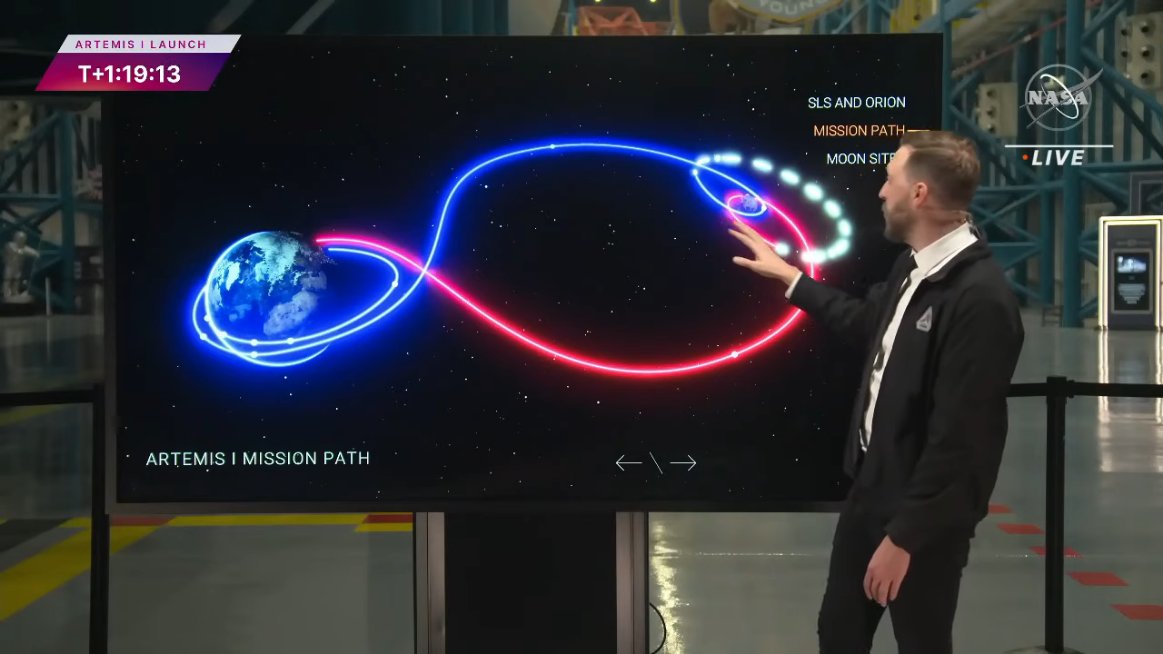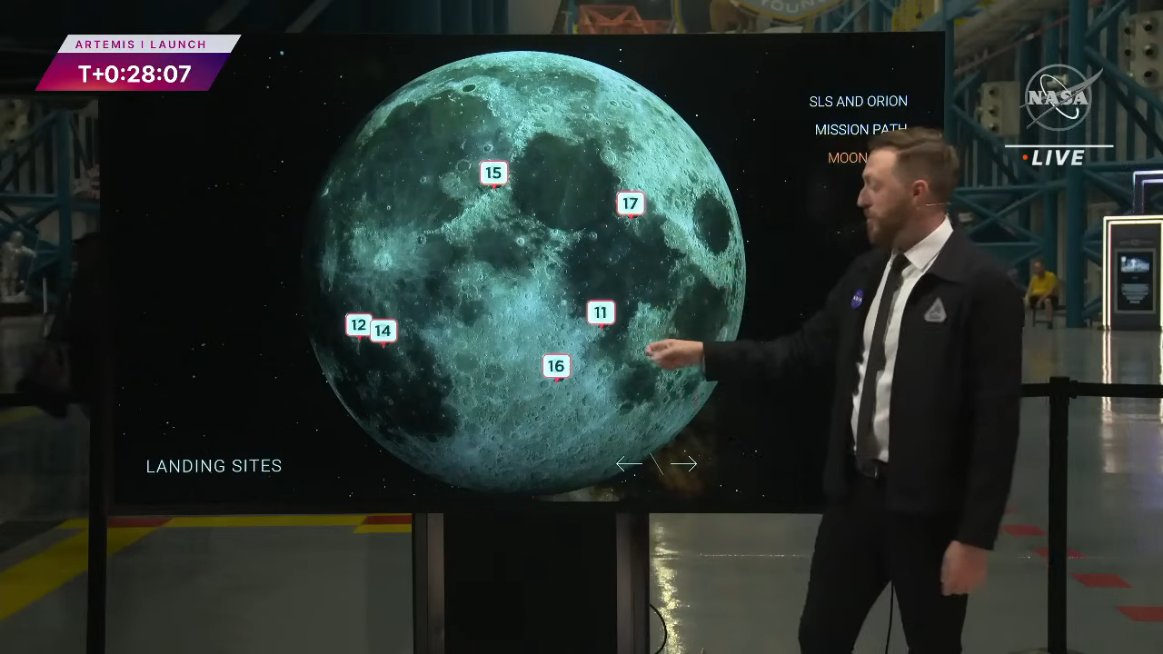Last month, NASA debuted the agency’s most advanced launch vehicle since the Space Shuttle. The Artemis I Space Launch System (SLS) rocket lifted off from Launch Complex-39B, at NASA’s Kennedy Space Center (KSC), in Florida on Nov. 16, sending an uncrewed Orion spacecraft on a 25-and-a-half-day trip around the moon and back.
In addition to the thousands lucky enough to see SLS launch in-person, a magnitude higher watched from afar through NASA’s broadcast and internet livestreams — which have now been viewed over 10 million times, according to data provided by space agency officials. In fact, NASA’s Artemis I broadcast included live feeds from multiple KSC locations, with cameras at the launchpad, anchored coverage with NASA’s Meagan Cruz at the KSC media site overlooking SLS, input from NASA broadcast and launch commentator Derrol Nail, and a live presentation at the KSC’s Saturn V Center with NASA’s Dan Huot.
Tucked underneath the five huge rocket engines affixed to the business-end of America’s first moon rocket on display inside the Saturn V Center, Huot controlled a not-so-meager hundred-inch, high-definition, interactive touchscreen monitor to help viewers visualize every step of the Artemis I mission. The huge touch display is endearingly referred to by NASA’s media team as the “Moonboard,” (according to Nail, a name thought-up by his wife), and the Artemis I launch coverage served as the board’s broadcast debut.
Just as NASA’s Artemis program has the potential to inspire a new generation, the agency’s revolutionary Moonboard could likewise influence the way audiences understand and experience spaceflight for years to come.
Related: NASA’s Artemis program: Everything you need to know
Live updates: NASA’s Artemis 1 moon mission
The launch of Artemis 1 was nearly a dozen years in the making, and represents the efforts of countless NASA engineers, contractors and mission specialists from across the United States, many of whom flocked to Florida’s Space Coast to witness the launch. And, while some NASA employees were able to sit back (perhaps nervously) to finally watch the fruits of their labor leave planet Earth, others at the space agency marched into launch day mission-ready and laser-focused on getting Artemis I off the pad. And for a few NASA personnel who showed up on launch day, the goal was to share the experience with the world.
To help viewers across the globe witness the Artemis I launch, NASA’s media team premiered some dynamic, high-tech advancements in their ability to present the historical event in all its glory. “Other centers, like JSC, are still 720[p],” NASA executive producer Sami Aziz told Space.com, referring to the broadcast quality capabilities of major NASA facilities across the United States. However, that’s no longer the case at KSC. According to Aziz, teams at the space center have spent the past five years upgrading infrastructure to support 4K broadcasting and streaming capabilities in anticipation of their extensive Artemis coverage.
For Aziz and the NASA media team, broadcasting the launch of SLS was about shining a light on Artemis in a way accessible to everyone. “How do we tell this story? How do we make sure that everybody digests this, follows this and understands the complexity,” Aziz said he asked himself and his team. “Once you’re in NASA or with the media, you understand […] some of these terms and acronyms. Even ‘SLS,’ for somebody who’s just tuning in, they have no idea what that is. So how do we make sure that […] they’re digesting this content? That was the goal from the beginning.”
.@DanNASA walking us through the European Service Module’s propulsion system, which will soon be steering @NASA_Orion #ForwardToTheMoon. Coming up soon: translunar injection burn of 18 mins. Cool explanation Dan 👏😉 #Artemis pic.twitter.com/lzl4QLhfhZNovember 16, 2022
The Moonboard was the brainchild of Derrol Nail. Nail is a former journalist, and says he was inspired by election coverage from major news networks. “I really liked how they used large interactive touchscreens to bring the numbers to life. In the same way, I wanted to bring the details of the Artemis I mission to life for the public,” Nail told Space.com.
“‘How do we amplify commentary?’ was basically the goal here,” Aziz said. “Derrol had the idea, and then it was discussed internally. And obviously everything is done by big committees here at NASA, so people have to buy-in to the idea and understand what it is. It’s a lot harder when it’s just an idea being pitched on paper — and then actually seeing it […] We got a great response to it.”
Huot stood with the massive presentation piece beneath the end of the Saturn V rocket, near the entrance to the Saturn V Center, where Aziz says a notable crowd gathered during the broadcast, which is exactly what he hoped would happen. “Let’s get a crowd going,” Aziz said of his approach to the Moonboard setup. “Let’s get people surrounding Dan, asking questions […] so for each moonboard hit there was a little crowd there watching as well, which was kind of exciting. To juxtapose it with the Saturn V hanging above his head, and show the brand new rocket I think was really great, and the space lends itself beautifully for the Moonboard,” he said.
As for its functionality, NASA’s media team worked with contractor Media Fusion to develop the interactive software and animation to demonstrate various stages of the Artemis I mission from pre-launch through splashdown of the Orion capsule in the Pacific Ocean. “We went through several rounds of finding glitches, fixes, and consistency errors,” Aziz said. “That was probably four to five months or prep,” he added, noting his team’s attention to detail. “We wanted to make sure it looked perfect, and really conveyed the agency’s messaging.”
“It’s not exactly like your phone,” Aziz explained. “You have to get used to that friction on the screen. You can adjust the sensitivity levels on it. Like, at some point we would touch it and it would just be very jerky and fast, but then we learned how to kind of manipulate it and work with that. We adjusted the video card and graphics and lighting — we had to make sure the lighting matched so it didn’t look overexposed or blown out on screen. So, lighting that thing was difficult as well — to make sure that you don’t see reflections in it, and make it super crystal clear for the viewer.”
The Moonboard, it’s worth noting, is more than just the giant touchscreen audiences saw during the broadcast. An incredibly powerful computer was needed to handle the on-screen graphics, thanks in part to a top-of-the-line video card. “[Media Fusion] chose to write the software using the free computer graphics game engine ‘Unreal Engine’. The software exceeded my expectations, and since final delivery it has performed nearly flawlessly,” Nail told Space.com. The giant screen/PC combo requires a box truck to transport, and comes with its own box casing to protect the pair while traveling.
When it came time for broadcast, the Moonboard was fully prepared to cover every step of the Artemis I mission. Aziz says the Moonboard was especially useful during aspects of the mission after launch, once Orion was in space. Beyond just vehicle animations, the Moonboard is capable of expanding different on-screen elements to dive into the details of other mission components.

“Let’s talk about the complexity of what goes on on launch day,” Aziz said in his Space.com interview. “We definitely need a mission overview so we can talk about all the different points,” he explained. “SLS is one thing, but what’s in space? It’s Orion and the service module […] When we’re talking about things like perigee raise maneuver, translunar injection, ICPS separation, distant retrograde orbit, what does all that mean? But being able to show it on a map, showing it on a giant mission overview, being able to show what the spacecraft looks like at that point, the orientation, things like that — are super critical.”
The Moonboard was also used to focus on lunar surface features. Referring to mission aspects following the initial launch of SLS, Aziz stressed the importance of placing the Artemis mission in the proper context for viewers. “Let’s look to the future and highlight Apollo landing sites, but also talk about where Artemis is going,” he explained. “We’re not redoing the same mission. We already proved that we can go [to the moon]. Now we’re going back to live and work, and visit a new region where we hope to have water-ice, where we hope to have more to explore — and that’s the South Pole.” Being able to demonstrate all that on an interactive lunar globe, Aziz says, “proved to be an incredibly valuable asset for us.”

After wrapping up NASA’s initial Artemis launch coverage, the Moonboard was packed up and taken from the Saturn V Center for storage. Beforehand, NASA media shot segments using the Moonboard for Orion’s return and splashdown, expected to take place December 11, but the agency does not intend to set the device back up again to cover that aspect of the mission. According to Aziz, “the Moonboard was primarily focused on launch and the general mission overview. And for splashdown, we have a couple of pre-recorded hits that we’re going to include,” he said.
Asked what those segments will look like, Aziz explained, “it’s brief, but we do have crew module/service module separation, so we can show that. And then we also have the entry interface, which is basically the Orion hitting the atmosphere, and you see all that heat. And that’s where we can describe the skip reentry maneuver, and describe the heat and the velocity. And then we just have a graphic of Orion bobbing in the water, post-splashdown, and the recovery ship in the background, just animated.”
As for what’s next for the Moonboard, Aziz thinks the demonstration tool has a lot of potential for other NASA broadcasting opportunities. “I don’t think it bodes itself for every NASA mission. But for those big things that we know matter to the agency, [the Moonboard] would engage the public in a different way and help disseminate this information. I think the Moonboard definitely adds another level,” he said. “It’s something that I now think we have a proof of concept. Like think about all these EVAs that we’re doing on the ISS. How cool would it be to have a Moonboard of the ISS that could add to that commentary?”
Follow us on Twitter @Spacedotcom (opens in new tab) or on Facebook (opens in new tab).

